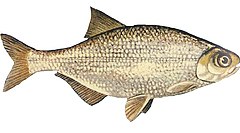Hiodon
| Mooneyes | |
|---|---|
 |
|
| Hiodon tergisus | |
| Scientific classification | |
| Kingdom: | Animalia |
| Phylum: | Chordata |
| Class: | Actinopterygii |
| Order: |
Hiodontiformes Taverne, 1979 |
| Family: |
Hiodontidae Cuvier & Valenciennes, 1846 |
| Genus: |
Hiodon Lesueur, 1818 |
| Species | |
| Synonyms | |
|
Eohiodon Cavender, 1966 |
|
Eohiodon Cavender, 1966
The mooneyes are a family, the Hiodontidae, of ray-finned fish comprising two living and three extinct species in the genus Hiodon. They are large-eyed, fork-tailed fish that physically resemble shads. Their common name comes from the metallic gold or silver shine of their eyes.
The higher classification of the mooneyes is not as yet fully established. Some sources place them in their own Order - Hiodontiformes (as in the treatment here), while others retain them in the order Osteoglossiformes.
The mooneye (Hiodon tergisus Lesueur, 1818) is widespread across North America, living in the clear waters of lakes, ponds, and rivers. It consumes aquatic invertebrates, insects, and fish. Mooneyes can reach 47 centimetres (19 in) in length.
Mooneyes feed readily on terrestrial insects, and will provide fine sport for an intrepid flyrod angler. They will also take small lures and natural baits with gusto. Mooneyes are frantic, hyperactive fish and their impressive leaps and passionate fighting style has earned them the nickname "Freshwater Tarpon".
The goldeye (Hiodon alosoides (Rafinesque, 1819)) is also widespread across North America, and is notable for a conspicuous golden iris in the eyes. It prefers turbid slower-moving waters of lakes and rivers, where it feeds on a wide variety of organisms including insects, crustaceans, small fish, and mollusks. The fish has been reported up to 52 centimetres (20 in) in length. The smoked meat is highly valued and sold as "Winnipeg goldeye".
...
Wikipedia
